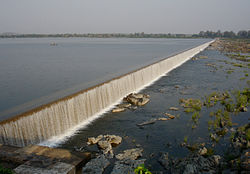This article needs additional citations for verification .(January 2023) |
Ashti Ashti | |
|---|---|
Urban | |
| Coordinates: 21°12′31.46″N78°11′22.7″E / 21.2087389°N 78.189639°E | |
| Country | |
| State | Maharashtra |
| District | Wardha |
| Founded by | Nawab Mohmmad Khan Niazi who was an Afghan noblemen. He worked as a mansabdar and jagirdar in the Mughal empire during the reign of Emperor Akbar. |
| Languages | |
| • Official | Marathi |
| Time zone | UTC+5:30 (IST) |
| ISO 3166 code | IN-MH |
| Vehicle registration | MH-32 |
Ashti(Shahid) is a town and the tehsil headquarters in Arvi subdivision of Wardha district in the Indian state of Maharashtra. Ashti is a historical place famous for the participation in Indian independence movement and Tomb of Nawab Muhammad khan Niazi . People actively took part in Quit India Movement in 1942. Ashti is also known as shahidon ki Ashti.







